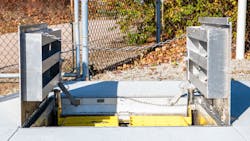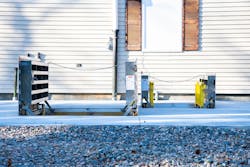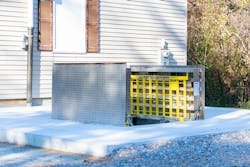Workplace falls are frequent, according to the National Institute for Occupational Safety and Health. In 2018, 27 percent of the more than 900,000 non-fatal work injuries resulting in days away from work were related to slips, trips and falls.
Because there is so much water around, slips and falls are a significant hazard at water treatment facilities. The danger escalates as workers often have to walk on elevated surfaces, ladders, roofs and skylights. Workers also step onto storage tanks, vehicles and roofs at wastewater facilities during routine parts of their jobs. The danger workers face was evident in a 2014 accident in New York, when a worker at a wastewater facility fell into a process tank and drowned.
While not all wastewater slips and falls are deadly, government officials need to take precautions to protect workers with equipment that can help prevent tragic consequences.
Protecting workers from fall hazards was among the chief concerns in Waterford, Conn., when it replaced nine doors at its wastewater treatment facilities. The project, completed last year, included the installation of doors manufactured by BILCO, which include factory-installed fall protection grating. The doors that were replaced were decades-old and lacked fall protection.
“The old hatches were not required to have fall protection,” said Jim Bartelli, assistant director of the Waterford Utility Commission. “When the hatches are open, workers could possibly trip and fall into the opening. The new hatches have fall protection provisions that meet OSHA standards.”
Replacing Doors
The Waterford project required the removal and installation of nine doors to gain access to wet wells at the water treatment plant for inspection, repair and cleaning.
Recent developments have required treatment plant workers to access doors more frequently, to clean out clogs in wet wells. Furthermore, the corrosive environment of wastewater treatment facilities can lead to premature deterioration of equipment, requiring replacement. Contaminants and moisture create a highly toxic environment, expediting corrosion. A plant in Florida replaced doors on its facility in 2020 after they became a fall hazard due to corrosion and decay caused by the harsh environment around the plant.
Solving the Problem
The hatches replaced in the Waterford project had experienced some corrosion. In addition to the wastewater environment, the community sits close to Long Island Sound and is just 46 feet above sea level.
The BILCO doors used in the replacement averaged 4-feet by 5-feet and were installed at-grade to allow access to the wet wells.
“The BILCO doors have a much wider opening, which will allow better access to the wet well for removing debris from the wet well baskets,” Bartelli said.
Bartelli said the doors also seal better, which is especially critical in that one of the town’s stations sits in a flood plain area.
Work on the project included the removal of existing doors, excavating around the perimeter, re-pouring concrete and some asphalt repair. Work needed to be done in stages because the pump stations are active work sites.
“This was a project that was part of our capital plan,” Bartelli said. “A study was recently conducted and over a period of time, many of our wastewater pumping stations could be impacted by tidal water levels. We needed to expand our water-tight manhole covers and install these hatches. In the event we do have a problem with tidal flooding, we will not be bringing seawater into the wastewater system.”
The doors used in the Waterford project also included a factory-installed fall protection grating. The grating meets OSHA requirements for fall protection and allows workers to safely inspect underground areas.
Most workers realize the hazards that are inherent at water treatment facilities, but having the proper equipment and safety measures in place can go a long way toward making sure they do not take unnecessary risks and prevent community-grieving tragedies. WW
About the Author: Thomas Renner writes on building, construction, manufacturing and other topics for trade publications throughout the United States and Canada.



